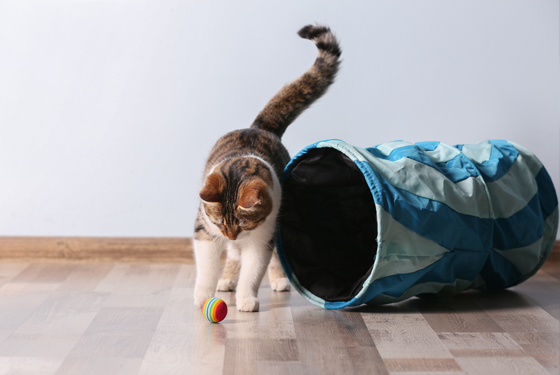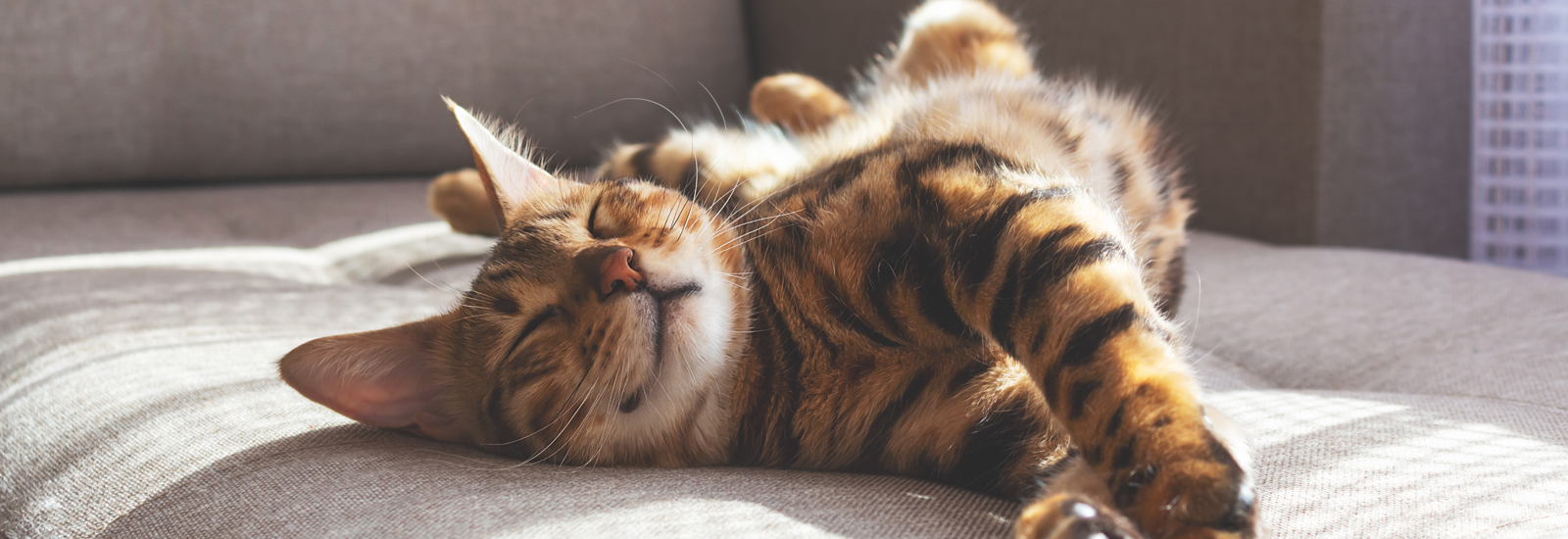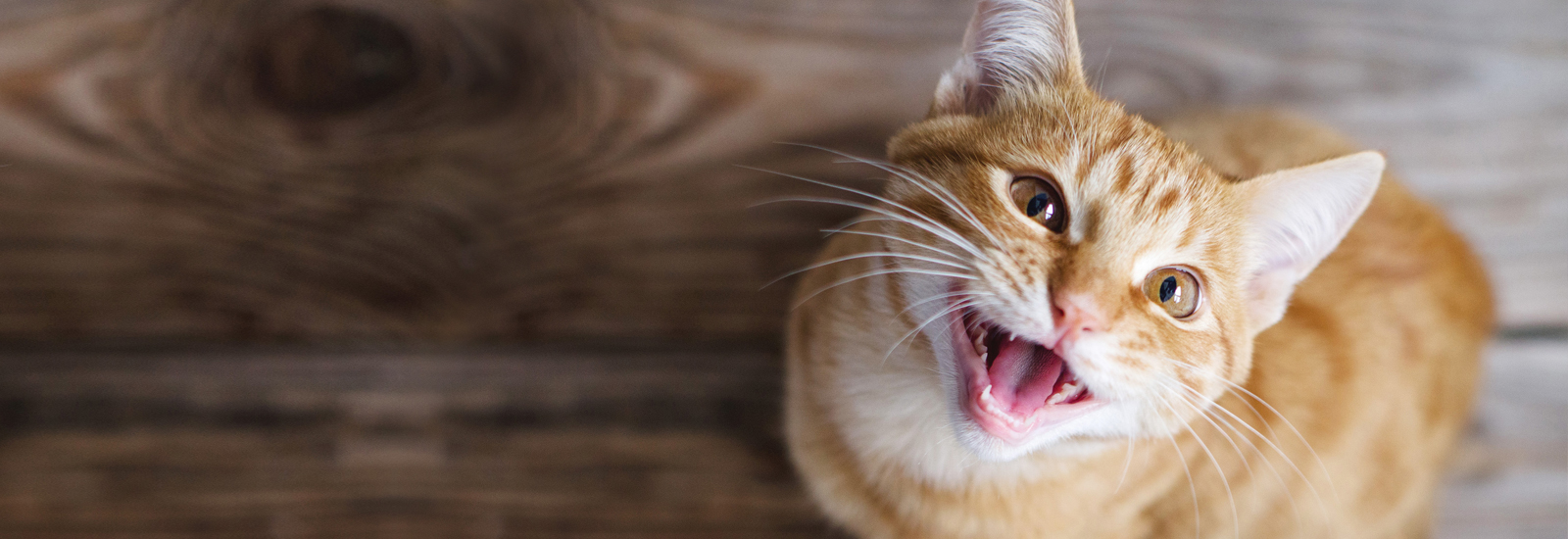Understanding and learning cat language
The cat language in the communication between cats and humans consists mainly of sounds. Among themselves, however, cats communicate more through body signals. If you listen carefully and pay close attention to your cat, you can learn a lot.
What do cats do if they like you?
Anyone who wants to understand the language of cats will be particularly interested in whether the cat is fond of them and loves them. There are various signs that indicate this:
- Head-butts
When a cat brushes against your legs and rubs its head on you, this is a clear sign of love. - Kneading
Kittens stimulate their mother’s milk flow by “kneading” her tummy to make sure that they always get enough to drink. If your adult cat uses its paws to “knead” you, this is a sign that your pet is happy and it can also be seen as an expression of love. - Presents
If your cat is allowed outside and brings you a mouse as a present, do not show any (negative) reaction. Your pet is simply trying to please you. - Purring
If a cat likes you, it will often start purring. Simply enjoy the moment and treat yourself to a little break. - The sleeping position
If a cat comes over to you on the couch without being asked, cuddles up to you, lies on top of you, and perhaps even shows you its (vulnerable) tummy, you can also rest assured that the cat is very fond of you.
What does it mean when a cat meows?
Cats are fairly silent animals that often use body language or scents to communicate with each other. Kittens, however, meow fairly often, because it is a very simple way of attracting their mother’s attention. This may well be why cats often use this type of communication with their humans. They soon realise that body language doesn’t seem to help much – a meow, on the other hand, will quickly attract attention. Very talkative cats therefore tend to meow at every opportunity.
This is their way of telling us that it’s mealtime, that they want to go in or out, that they’re bored or that they simply don’t like something. Cat owners usually know instinctively exactly what their pet is trying to tell them. Perhaps your cat’s bowl has been empty for too long, you have not been giving your pet enough attention today, or it simply cannot wait to go outside and inspect its territory.
When do cats purr?
Cats are born deaf, so they cannot yet hear a meow. But they do notice purring because it creates vibrations. A kitten knows when its mother is purring. This helps it to find its way to her, makes it feel protected and allows it to feed. Cats therefore have very positive associations with purring, so they also use it in their communication with humans. When they are perfectly happy, they purr. There is, however, one interesting exception to this: when cats are ill, they sometimes purr in order to soothe themselves.
What does a cat say with its tail?
Communication between cats works very well via body language. For example, you can see a cat moving its tail even from a distance. Is the tail jerking back and forth, is it raised vertically or is it hanging down inconspicuously? This can reveal a great deal about the cat’s mood. Usually, in its normal state, it simply hangs downwards with a slight bend in it. If the cat waves its tail back and forth, it is probably in a playful mood or wants attention.
If it tucks its tail between its hind legs, it is scared. If the tail is twitching around, the cat is tense, and if it is standing upright, this can be an indication both of joy and emerging aggression. Understanding the language of a cat always depends on the individual situation – including when the cat thrashes with the tip of its tail. In this way, it reveals an inner restlessness. Maybe it is in the middle of an exciting game or on the hunt and about to pounce.

The use of the eyes and ears in cat language
Anyone who wants to understand the language of cats must pay attention to every detail. This also includes the position of the ears. They are almost always wide open and pointing upwards in order to pick up sounds perfectly. When a cat hears something, it moves its ears back and forth in order to find out where the sound is coming from. Once the sound has been identified, the cat will relax again, but otherwise its ears will keep on moving. If there is a threat of danger or trouble, the cat will flatten its ears. This not only reflects its mood, but also acts as protection against possible injuries by an attacker.
You should also observe a cat’s eyes in order to determine its mood. If it blinks every now and then and looks around in a carefree way, everything is fine. If, however, its eyes are wide open or half-closed, it may be feeling uneasy or even threatened. If the cat arches its back and its fur stands on end, this is also a sign of distress. If it hisses and lifts up one of its front paws, then it is clearly no longer amused.
Summary
Cat language is extremely versatile. If you want to learn it, then you have to observe your cat very closely. The eyes, ears, tail and posture of your pet will reveal a great deal. Cats also like to communicate with us via sounds, because they know that we will respond to them more quickly. If you take the time to closely observe your cat - and this is something that cats often do with us - you will soon start to understand the language of cats more and more.
You may also like this

Getting cats used to each other
This is how you successfully get cats used to each other

Territorial behavior
Territorial behavior of outdoor and indoor cats

Getting your cat used to being outdoors
This is how you get your cat used to being outdoors.

Moving with cat
Tips for moving with your cat

